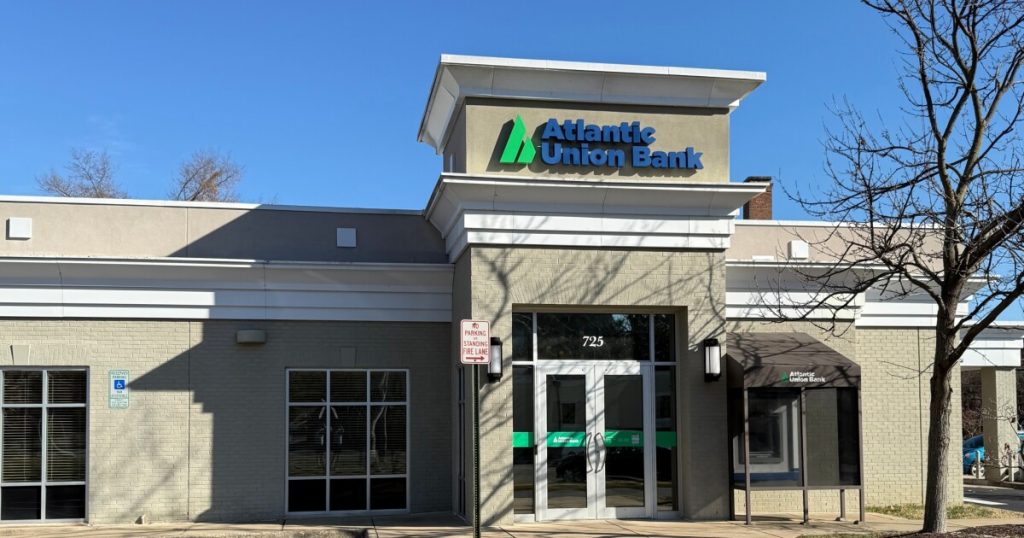- Forward look: Atlantic Union joins a lengthening list of banks seeking to expand into North Carolina, announcing plans to build 10 branches in Raleigh and Wilmington.
- Key insight: CEO John Asbury said the company will move to the M&A sideline as it works to capitalize on its recent acquisition of a Maryland bank.
- Expert Quote: “We’re paying attention to what’s going on in and around D.C., with the shutdown. We just don’t see any weakness anywhere,” said Chief Credit Officer Doug Woolley.
Atlantic Union Bankshares announced plans Thursday to construct 10 branches in North Carolina over the next three years, ramping up its
“There’s very positive momentum there,” Executive Vice President David Ring said Thursday on a conference call with analysts. “What we like about North Carolina is [that] it is a real active market. You can drive down any highway and see multiple manufacturing and distribution facilities. We’ve placed a lot of talent in that market to go after that business.”
Other banks have done the same. Indeed, the Carolinas have emerged as a magnet for out-of-state banks in recent years, as
Atlantic Union Bankshares
While the $37.1 billion-asset Atlantic Union’s footprint includes Maryland, the District of Columbia and Virginia, the Carolinas are “arguably the best of the growth markets where we have a physical presence,” CEO John Asbury said on the conference call.
Atlantic Union currently operates 11 branches in North Carolina. The expansion plan envisions seven new locations in Raleigh and three in Wilmington, plus the installation of 49 off-site automatic teller machines.
One strategy that has apparently been pushed to the back burner is acquisitions. As Atlantic Union bids for growth to the south, it’s also determined to prove its
“To some extent, we’re a show-me story,” Asbury told American Banker last week. “Now we need to demonstrate the power of the franchise.”
“We don’t need to do any more mergers any time soon,” Asbury added. “I think we will be an organic story, certainly through 2026.”
Atlantic Union completed the integration of Sandy Spring over the Columbus Day weekend, closing the books on a transaction that fulfills a strategic vision Asbury spent nearly a decade pursuing.
The deal locked into place a mid-Atlantic franchise stretching from Baltimore to Raleigh. Asbury, who has led Atlantic Union since January 2017, calls that region the “golden crescent.”
“We have spent nine years building exactly the franchise we wanted,” Asbury said. “We’ve done exactly what we said we would do. … All the pieces have come into place.”
Atlantic Union on Thursday reported a third-quarter profit totaling $92.1 million, or $89.3 million after a preferred-stock dividend payout. Its second-quarter earnings of $16.8 million were impacted by costs connected to the Sandy Spring merger, which closed April 1.
Loans totaled $27.4 billion on Sept. 30. Third-quarter annualized loan growth amounted to a modest 0.5%, but Atlantic Union expects an uptick in growth, to the mid-single digits, in the fourth quarter and into 2026, as the company begins to push deals through its burgeoning pipelines.
“If pull-through is what we expect it to be, we think we’ll have a good, solid fourth quarter,” Ring said.
Atlantic Union charged off two previously identified problem loans during the three months that ended on Sept. 30. Though the moves pushed the net charge-off ratio for the quarter to 0.56% of average loans held for investment, overall credit trends were positive, with the levels of nonperforming and criticized loans both declining.
“Broadly speaking, the overall credit trends look good,” Asbury said on the conference call. “You can see that in our numbers. … Past dues down, criticized down. We feel pretty good.”
Three weeks into the fourth quarter, credit quality remained solid even in the markets around Washington, D.C., that have been impacted by the ongoing government shutdown. Atlantic Union’s government contracting business is concentrated in the defense sector and has seen little if any deterioration, according to Asbury and Chief Credit Officer Doug Woolley.
“We’re paying attention to what’s going on in and around D.C., with the shutdown,” Woolley said. “We just don’t see any weakness anywhere.”
In a research note, Stephen Scouten, who covers Atlantic Union for Piper Sandler, characterized the uptick in third-quarter charge-offs a “bad optic.” But he noted that the bank restated its 0.15% net charge-off guidance for all of 2025 to 0.20%, “so this should not be a lingering concern.”
“Obviously, it’s all about where [Atlantic Union] gets run-rate earnings to” in the first quarter of next year, Scouten wrote in the research note.
With its loan pipelines filling and the Sandy Spring integration completed — four months ahead of the original schedule — Atlantic Union is “well-positioned to deliver sustainable growth,” Asbury said on the conference call.
The quicker Sandy Spring integration timetable was made possible by regulatory approvals that arrived three months ahead of the company’s expectations. At first, Atlantic Union planned to take its time with the integration and stick to the initial February 2026 time frame. However, as the process got underway, the company’s outlook shifted.
“About 30 days in, as we studied it, we came back and said, ‘Having assessed this, we believe we can be ready Oct. 1, and it is to everyone’s advantage to get the conversion done sooner,'” Asbury said in the interview.

